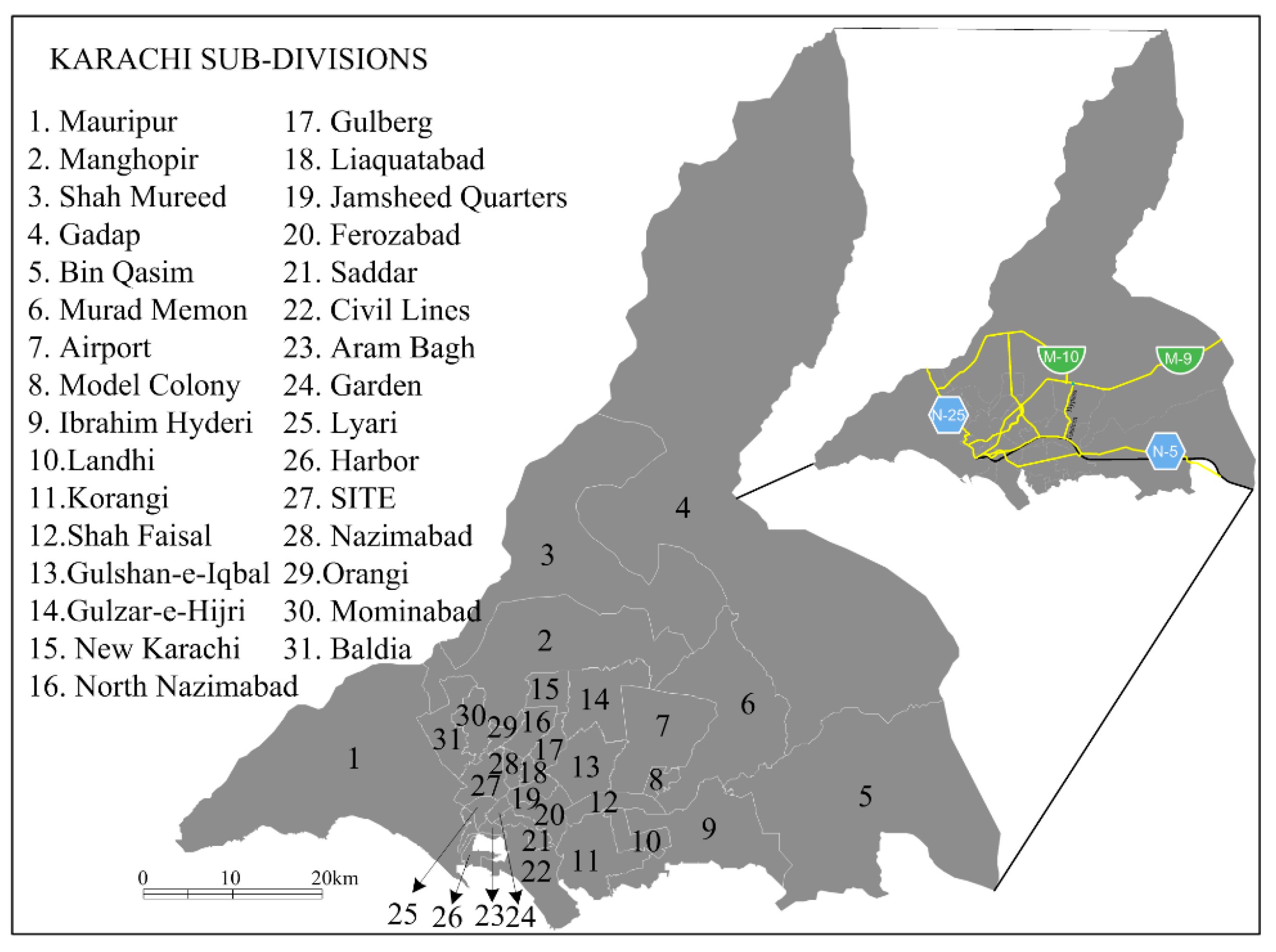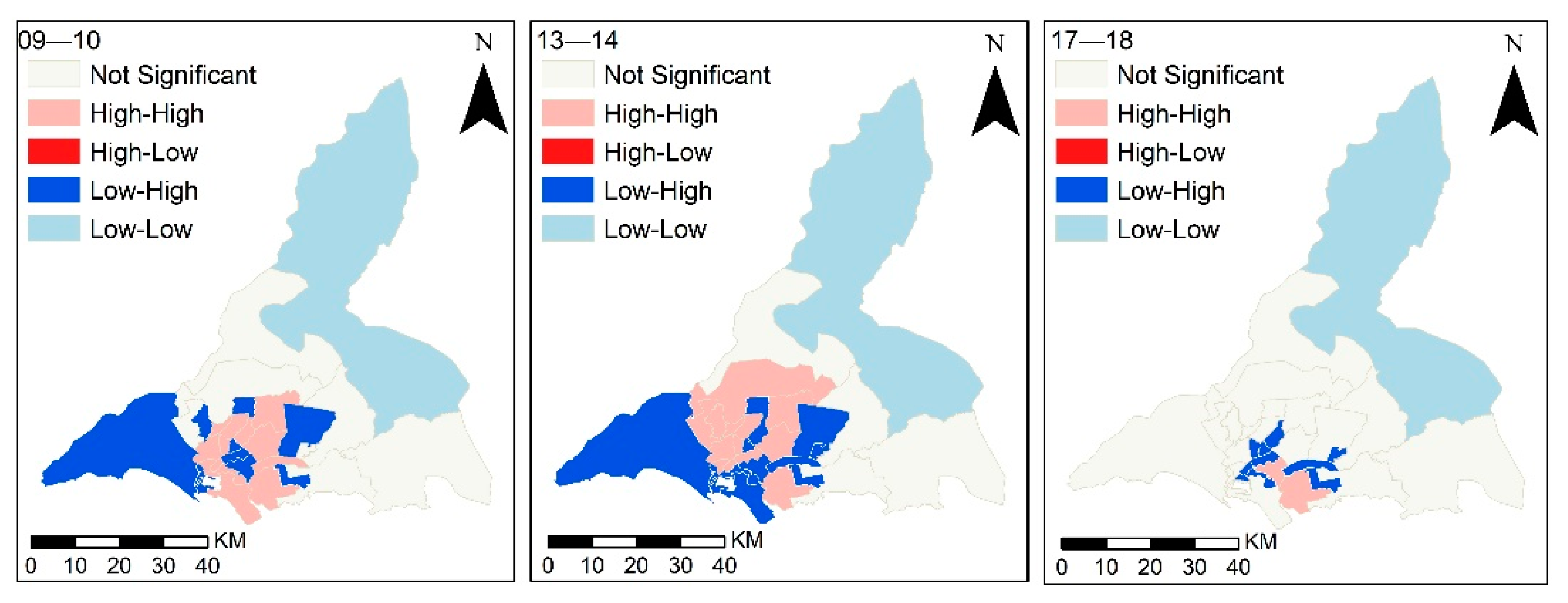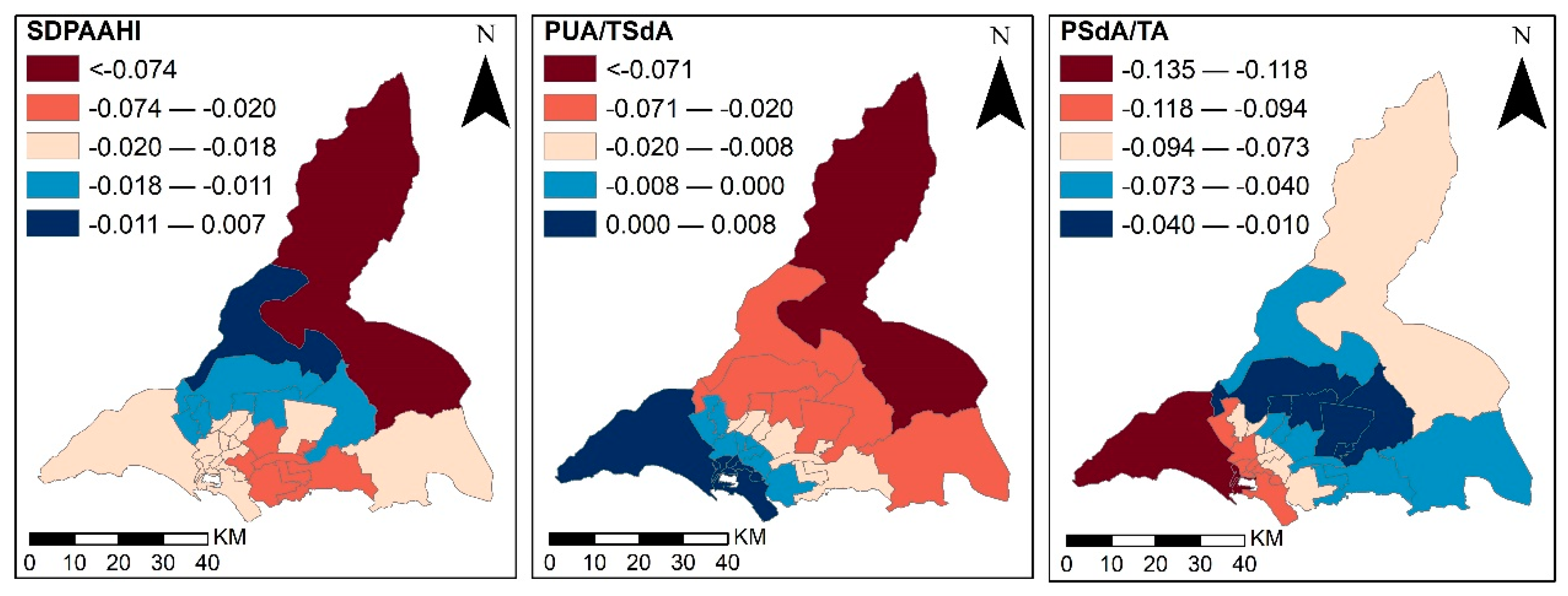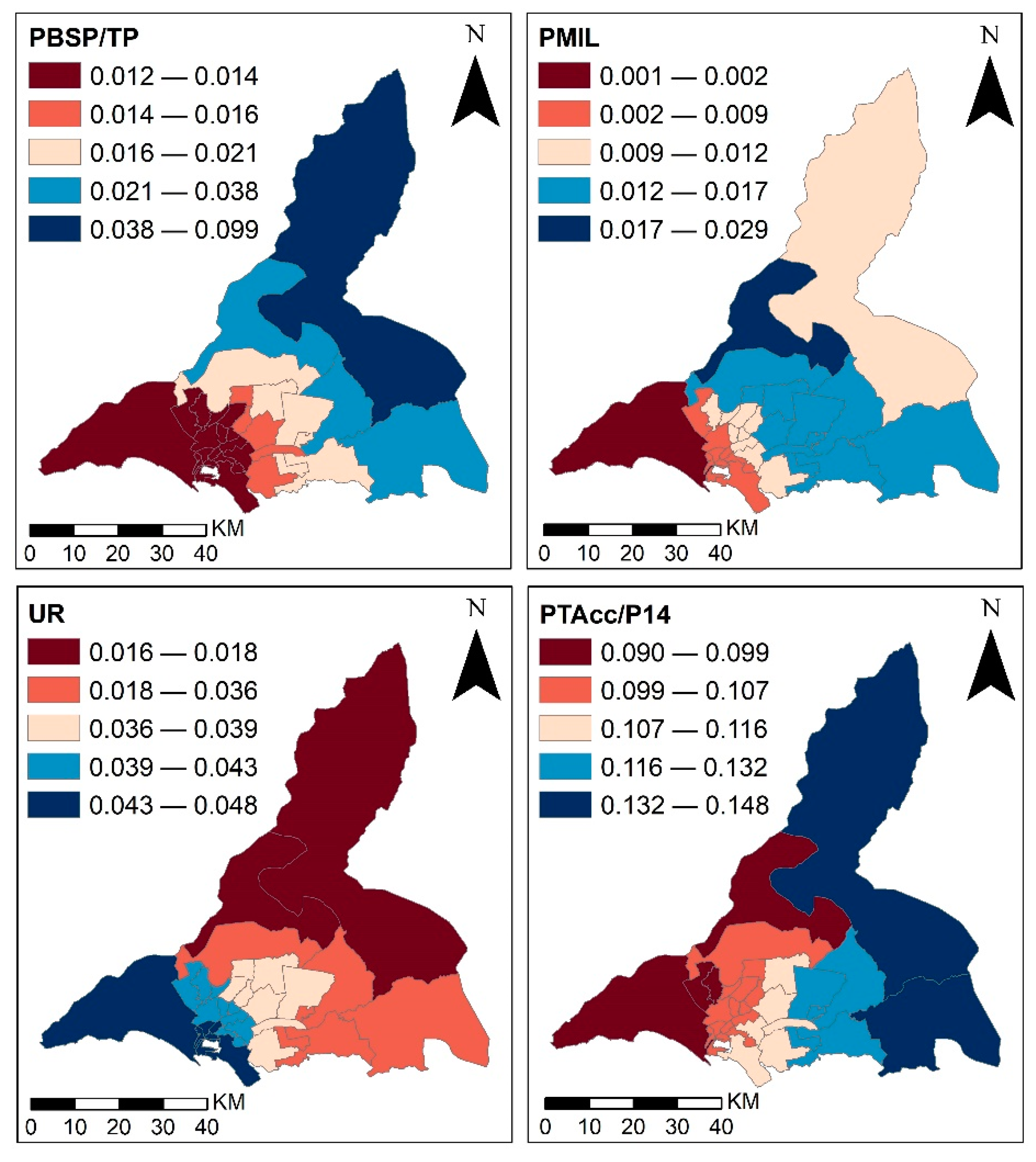The Relationship between Neighborhood Characteristics and Homicide in Karachi, Pakistan
Abstract
:1. Introduction
2. Background Theories
3. Materials and Methods
3.1. Study Area
3.2. Data
3.3. Methodology
3.3.1. Spatio-Temporal Analysis
3.3.2. Regression Analysis
4. Results and Discussion
4.1. Spatio-Temporal Analysis
4.2. Regression Analysis
4.3. Implications and Limitations
5. Conclusions
Author Contributions
Funding
Institutional Review Board Statement
Informed Consent Statement
Data Availability Statement
Acknowledgments
Conflicts of Interest
References
- United Nations. Transforming Our World: The 2030 Agenda for Sustainable Development; United Nations: San Francisco, CA, USA, 2015.
- Sharkey, P.S.; Sampson, R.J. Violence, Cognition, and Neighborhood Inequality in America. In Social Neuroscience: Brain, Mind, and Society; Schutt, R.K., Seidman, L.J., Keshavan, M.S., Eds.; Harvard University Press: Cambridge, MA, USA, 2015. [Google Scholar]
- Doob, A.N.; Webster, C.M. Sentence Severity and Crime: Accepting the Null Hypothesis. Crime Justice 2003, 30, 143–195. [Google Scholar] [CrossRef]
- Briceño-León, R.; Villaveces, A.; Concha-Eastman, A. Understanding the uneven distribution of the incidence of homicide in Latin America. Int. J. Epidemiol. 2008, 37, 751–757. [Google Scholar] [CrossRef] [PubMed] [Green Version]
- McCall, P.L.; Land, K.C.; Parker, K.F. An Empirical Assessment of What We Know About Structural Covariates of Homicide Rates: A Return to a Classic 20 Years Later. Homicide Stud. 2010, 14, 219–243. [Google Scholar] [CrossRef]
- Sampson, R.J.; Raudenbush, S.W.; Earls, F. Neighborhoods and Violent Crime: A Multilevel Study of Collective Efficacy. Science 1997, 277, 918–924. [Google Scholar] [CrossRef]
- Choe, J. Income inequality and crime in the United States. Econ. Lett. 2008, 101, 31–33. [Google Scholar] [CrossRef]
- Fajnzylber, P.; Lederman, D.; Loayza, N. Inequality and Violent Crime. J. Law Econ. 2002, 45, 1–39. [Google Scholar] [CrossRef] [Green Version]
- Stacy, C.P.; Ho, H.; Pendall, R. Neighborhood-Level Economic Activity and Crime. J. Urban Aff. 2016. [Google Scholar] [CrossRef]
- Hasisi, B.; Perry, S.; Ilan, Y.; Wolfowicz, M. Concentrated and Close to Home: The Spatial Clustering and Distance Decay of Lone Terrorist Vehicular Attacks. J. Quant. Criminol. 2020, 36, 607–645. [Google Scholar] [CrossRef]
- Andresen, M.A. Estimating the probability of local crime clusters: The impact of immediate spatial neighbors. J. Crim. Justice 2011, 39, 394–404. [Google Scholar] [CrossRef]
- de Melo, S.N.; Matias, L.F.; Andresen, M.A. Crime concentrations and similarities in spatial crime patterns in a Brazilian context. Appl. Geogr. 2015, 62, 314–324. [Google Scholar] [CrossRef]
- Boivin, R. Routine activity, population(s) and crime: Spatial heterogeneity and conflicting Propositions about the neighborhood crime-population link. Appl. Geogr. 2018, 95, 79–87. [Google Scholar] [CrossRef]
- Law, J.; Quick, M. Exploring links between juvenile offenders and social disorganization at a large map scale: A Bayesian spatial modeling approach. J. Geogr. Syst. 2013, 15, 89–113. [Google Scholar] [CrossRef]
- McMillen, D.P. Geographically Weighted Regression: The Analysis of Spatially Varying Relationships. Am. J. Agric. Econ. 2004, 86, 554–556. [Google Scholar] [CrossRef]
- Murillo, F.H.S.; Chica-Olmo, J.; de Cortázar, A.R.G. The spatial heterogeneity of factors of feminicide: The case of Antioquia-Colombia. Appl. Geogr. 2018, 92, 63–73. [Google Scholar] [CrossRef]
- Chen, J.; Liu, L.; Liu, H.; Long, D.; Xu, C.; Zhou, H. The Spatial Heterogeneity of Factors of Drug Dealing: A Case Study from ZG, China. ISPRS Int. J. Geo-Inf. 2020, 9, 205. [Google Scholar] [CrossRef] [Green Version]
- Cohen, L.; Felson, M. Social Change and Crime Rate Trends: A Routine Activity Approach. Am. Sociol. Rev. 1979, 44, 588–608. [Google Scholar] [CrossRef]
- Roth, J.J. Gender Differences in Acquisitive Delinquency: A Macro-Level Routine Activities Analysis. Am. J. Crim. Justice 2016, 41, 796–813. [Google Scholar] [CrossRef]
- Fisher, B.; Wilkes, A. A Tale of Two Ivory Towers. A Comparative Analysis of Victimization Rates and Risks between University Students in the United States and England. Br. J. Criminol. 2003, 45, 526–545. [Google Scholar] [CrossRef]
- Tseloni, A.; Wittebrood, K.; Farrell, G.; Pease, K. Burglary Victimization in England and Wales, the United States and the Netherlands: A Cross-National Comparative Test of Routine Activities and Lifestyle Theories. Br. J. Criminol. 2004, 44, 66–91. [Google Scholar] [CrossRef]
- Sypion-Dutkowska, N.; Leitner, M. Land Use Influencing the Spatial Distribution of Urban Crime: A Case Study of Szczecin, Poland. ISPRS Int. J. Geo-Inf. 2017, 6, 74. [Google Scholar] [CrossRef] [Green Version]
- Stucky, T.D.; Ottensmann, J.R. Land Use and Violent Crime. Criminology 2009, 47, 1223–1264. [Google Scholar] [CrossRef] [Green Version]
- Anderson, J.M.; MacDonald, J.; Bluthenthal, R.; Ashwood, J. Reducing Crime by Shaping the Built Environment with Zoning: An Empirical Study of Los Angeles. Univ. Pa. Law Rev. 2013, 161, 699–757. [Google Scholar] [CrossRef] [Green Version]
- Jacobs, J. The Death and Life of Great American Cities; Random House: New York, NY, USA, 1961. [Google Scholar]
- MacDonald, J. Community Design and Crime: The Impact of Housing and the Built Environment. Crime Justice 2015, 44, 333–383. [Google Scholar] [CrossRef]
- Twinam, T. Danger zone: Land use and the geography of neighborhood crime. J. Urban Econ. 2017, 100, 104–119. [Google Scholar] [CrossRef]
- Pinchevsky, G.M.; Wright, E.M. The impact of neighborhoods on intimate partner violence and victimization. Trauma Violence Abus. 2012, 13, 112–132. [Google Scholar] [CrossRef]
- Cahill, M.E.; Mulligan, G.F. The Determinants of Crime in Tucson, Arizona1. Urban Geogr. 2003, 24, 582–610. [Google Scholar] [CrossRef]
- Andresen, M.A. Crime Measures and the Spatial Analysis of Criminal Activity. Br. J. Criminol. 2006, 46, 258–285. [Google Scholar] [CrossRef]
- Lu, L.; Weng, Q.; Guo, H.; Feng, S.; Li, Q. Assessment of urban environmental change using multi-source remote sensing time series (2000–2016): A comparative analysis in selected megacities in Eurasia. Sci. Total Environ. 2019, 684, 567–577. [Google Scholar] [CrossRef]
- Mangi, M.Y.; Yue, Z.; Kalwar, S.; Lashari, Z.A. Comparative Analysis of Urban Development Trends of Beijing and Karachi Metropolitan Areas. Sustainability 2020, 12, 451. [Google Scholar] [CrossRef] [Green Version]
- Schulenberg, J.L.; Jacob, J.C.; Carrington, P.J. Ecological Analysis of Crime Rates and Police Discretion with Young Persons: A Replication. Can. J. Criminol. Crim. Justice 2007, 49, 261–277. [Google Scholar] [CrossRef]
- Andresen, M.A. A spatial analysis of crime in Vancouver, British Columbia: A synthesis of social disorganization and routine activity theory. Can. Geogr./Le Géographe Can. 2006, 50, 487–502. [Google Scholar] [CrossRef]
- Osgood, D.W.; Chambers, J.M. Social disorganization outside the metropolis: An analysis of rural youth violence. Criminology 2000, 38, 81–116. [Google Scholar] [CrossRef] [Green Version]
- Khan, I.; Hamza, S.; Burke, F.; Nawaz-ul-Huda, S. Application of GIS for evaluation of ethnic fault lines of Karachi. Malays. J. Soc. Space 2020, 16, 15–29. [Google Scholar] [CrossRef]
- Khan, I.; Hamza, S.; Burke, P.D.F.; Nawaz-Ul-Huda, S.; Miandad, M. Mapping homicide motives and contributory factors in Karachi. Pak. Geogr. Rev. 2020, 75, 200–218. [Google Scholar]
- Bangash, A.K.; Khan, R.; Marwat, F.U.R. Illiteracy and its Relation with Honour Killing in Federally Administered Tribal Areas (FATA) Of Pakistan. Pak. J. Criminol. 2018, 10, 107–121. [Google Scholar]
- Latif, Z. Offending in Karachi’s Neighborhoods: An Empirical Test of the Systemic Model of Social Disorganization; City University of New York: New York, NY, USA, 2012. [Google Scholar]
- Kingston, B.; Huizinga, D.; Elliott, D.S. A test of social disorganization theory in high-risk urban neighborhoods. Youth Soc. 2009, 41, 53–79. [Google Scholar] [CrossRef]
- Jendryke, M.; McClure, S.C. Mapping crime—Hate crimes and hate groups in the USA: A spatial analysis with gridded data. Appl. Geogr. 2019, 111, 102072. [Google Scholar] [CrossRef]
- Anselin, L. Local Indicators of Spatial Association—LISA. Geogr. Anal. 1995, 27, 93–115. [Google Scholar] [CrossRef]
- Oshan, T.M.; Li, Z.; Kang, W.; Wolf, L.J.; Fotheringham, A.S. mgwr: A Python Implementation of Multiscale Geographically Weighted Regression for Investigating Process Spatial Heterogeneity and Scale. ISPRS Int. Geo-Inf. 2019, 8, 269. [Google Scholar] [CrossRef] [Green Version]
- Chotani, H.A.; Razzak, J.A.; Luby, S.P. Patterns of violence in Karachi, Pakistan. Inj. Prev. 2002, 8, 57–59. [Google Scholar] [CrossRef] [Green Version]
- Mian, A.; Mahmood, S.; Chotani, H.; Luby, S. Vulnerability to Homicide in Karachi: Political Activity as a Risk Factor. Int. J. Epidemiol. 2002, 31, 581–585. [Google Scholar] [CrossRef] [PubMed] [Green Version]
- Benson, B.L.; Siddiqui, Z.R. Pashtunwali—Law for the lawless, defense for the stateless. Int. Rev. Law Econ. 2014, 37, 108–120. [Google Scholar] [CrossRef]
- Yusuf, H. Conflict Dynamics in Karachi; United States Institute of Peace: Washington, DC, USA, 2012.
- Khan, N.; Ahmed, J.; Nawaz, M.; Zaman, K. The Socio-Economic Determinants of Crime in Pakistan: New Evidence on an Old Debate. Arab Econ. Bus. J. 2015, 10, 73–81. [Google Scholar] [CrossRef] [Green Version]
- Stahura, J.; Sloan, J. Urban Stratification of Places, Routine Activities and Suburban Crime Rates. Soc. Forces 1988, 66, 1102–1118. [Google Scholar] [CrossRef]
- Fasihuddin. Criminology and Criminal Justice System in Pakistan. In Handbook of Asian Criminology; Springer: New York, NY, USA, 2013; pp. 247–281. [Google Scholar] [CrossRef]
- Arshad, S.J. Criminal Justice System in Pakistan: A Critical Analysis. Available online: https://courtingthelaw.com/2017/02/15/commentary/criminal-justice-system-in-pakistan-a-critical-analysis/ (accessed on 19 March 2021).
- Brantingham, P.L.; Brantingham, P.L.; Vajihollahi, M.; Wuschke, K. Crime Analysis at Multiple Scales of Aggregation: A Topological Approach. In Putting Crime in Its Place; Weisburd, D., Bernasco, W., Bruinsma, G.J.N., Eds.; Springer: New York, NY, USA, 2009; pp. 87–107. [Google Scholar] [CrossRef]
- Harinam, V. Examining micro-level homicide patterns in toronto, 1967 through 2003. Can. J. Criminol. Crim. Justice 2020, 62, 44–63. [Google Scholar] [CrossRef]
- Abbas, H. Reforming Pakistan‘s Police and Law Enforcement Infrastructure; United States Institute of Peace: Washington, DC, USA, 2011.






| Group | Variable | Abbreviation |
|---|---|---|
| Population density | population density at the subdivision level | PD |
| Lingual distribution | % Urdu-speaking population/total population | PUSP/TP |
| % Punjabi-speaking population/total population | PPUSP/TP | |
| % Sindhi-speaking population/total population | PSPP/TP | |
| % Pashtu-speaking population/total population | PPASP/TP | |
| % Balochi-speaking population/total population | PBSP/TP | |
| % other language-speaking population/total population | POLSP/TP | |
| Education level | % literate population/population aged 10 and above | PLP |
| % male illiterates/total male population aged 10 and above | PMIL | |
| % female illiterates/total female population aged 10 and above | PFIL | |
| Economic status | unemployment rate | UR |
| average household income at subdivision planned settlements | SDPAAHI | |
| Land use | % planned area/total subdivision built-up area | PPA/TSDBA |
| % unplanned area/total subdivision built-up area | PUA/TSDA | |
| % commercial area/total subdivision built-up area | PCA/TSDA | |
| Police performance | % police personnel/total population of subdivisions | RPP/TPSD |
| % police surveillance area/total area | PSDA/TA | |
| % total accused persons/population aged 14 and above | PTAcc/P14+ | |
| % total arrested persons/total accused persons | PTArr/TAcc | |
| % police posted/sq. km. subdivision | RPP/SSD |
| Variable | GLM | GWPR | ||
|---|---|---|---|---|
| Min. | Median | Max. | ||
| Intercept | 2.317 ** | 2.126 | 2.466 | 4.017 |
| % Balochi-speaking population/total population (PBSP/TP) | 0.014 ** | 0.012 | 0.014 | 0.099 |
| % Male illiterates/total male population aged 10 and above (PMIL) | 0.012 ** | 0.002 | 0.011 | 0.029 |
| % Unemployment rate (UR) | 0.041 ** | 0.016 | 0.039 | 0.048 |
| Average household income at subdivision planned settlements (SDPAAHI) | −0.024 ** | −0.074 | −0.019 | 0.007 |
| % Unplanned area/total subdivision built-up area (PUA/TSdA) | −0.017 ** | −0.071 | −0.008 | 0.008 |
| % Police surveillance area/total area (PSdA/TA) | −0.072 ** | −0.135 | −0.073 | −0.010 |
| % Total accused persons/population aged 14 and above (subdivision) (PTAcc/P14+) | 0.123 ** | 0.090 | 0.106 | 0.148 |
| MAD | 89.887 | 53.320 | ||
| AICC | 112.433 | 100.845 | ||
| Percent deviance explained | 0.764 | 0.860 | ||
Publisher’s Note: MDPI stays neutral with regard to jurisdictional claims in published maps and institutional affiliations. |
© 2021 by the authors. Licensee MDPI, Basel, Switzerland. This article is an open access article distributed under the terms and conditions of the Creative Commons Attribution (CC BY) license (https://creativecommons.org/licenses/by/4.0/).
Share and Cite
Hamza, S.; Khan, I.; Lu, L.; Liu, H.; Burke, F.; Nawaz-ul-Huda, S.; Baqa, M.F.; Tariq, A. The Relationship between Neighborhood Characteristics and Homicide in Karachi, Pakistan. Sustainability 2021, 13, 5520. https://doi.org/10.3390/su13105520
Hamza S, Khan I, Lu L, Liu H, Burke F, Nawaz-ul-Huda S, Baqa MF, Tariq A. The Relationship between Neighborhood Characteristics and Homicide in Karachi, Pakistan. Sustainability. 2021; 13(10):5520. https://doi.org/10.3390/su13105520
Chicago/Turabian StyleHamza, Salma, Imran Khan, Linlin Lu, Hua Liu, Farkhunda Burke, Syed Nawaz-ul-Huda, Muhammad Fahad Baqa, and Aqil Tariq. 2021. "The Relationship between Neighborhood Characteristics and Homicide in Karachi, Pakistan" Sustainability 13, no. 10: 5520. https://doi.org/10.3390/su13105520
APA StyleHamza, S., Khan, I., Lu, L., Liu, H., Burke, F., Nawaz-ul-Huda, S., Baqa, M. F., & Tariq, A. (2021). The Relationship between Neighborhood Characteristics and Homicide in Karachi, Pakistan. Sustainability, 13(10), 5520. https://doi.org/10.3390/su13105520









